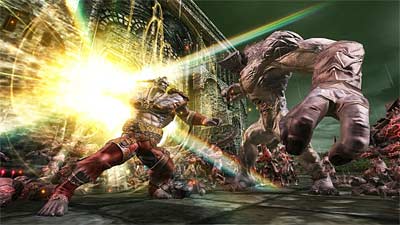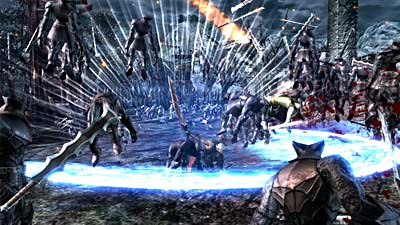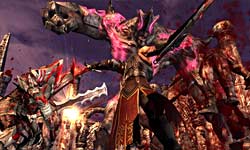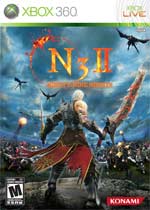Battle Fatigue
I hadn’t planned on playing N3II before I went to E3. Sitting in the audience at the Konami press conference, however, I saw the producer of the game, Tak Fujii, speak about it with a kind of enthusiasm that made me want to try it out (if you haven’t checked out the press highlights on Youtube, you should—for a fairly run-of-the-mill press event, there were some pretty ridiculous goings-on). In any case, I decided that N3II might actually be worth checking out, if only because Fujii himself had so much character.

I wish I could say the same thing about his game.
Maybe the bar of expectations needs to be set just a little lower with a genre as simple (and let’s face it—derivative) as hack-and-slash, which N3II undoubtedly is (quite clearly, and never in deviation from). But even within the fairly stringent design tenet of “slashing the living hell out of anything that moves until everything on screen is dead,” there should be variety. N3II has your standard two-attack (light and strong) weapon hit combo system, and there are additional moves, weapons, and abilities to unlock and level up. But sadly, it’s also one of those games that basically gives you a feel for the entire experience in about ten minutes of gameplay. The first ten minutes.
In the game’s defense, within the very limited design confines of a hack-and-slash title, N3II isn’t that bad, in theory. There are five different characters to choose from, all of whom interact around the same storyline, filling in their respective parts. The framerate is consistent, you can run pretty fast (handy for the game’s fairly large maps), and the enemies aren’t too cheap (most of the time). The graphics and effects are pretty, if a little understated, and the number of enemies on screen is impressive. So, what happened? Simple: no gameplay variety. In the first mission of the game, the evil Lord of the Night (apparently they were all out of original evil names) has captured a substantial piece of N3II’s archetypal fantasy real estate. Your job is to clear the grounds surrounding Elfin castle so you can enter and to meet with those inside. Clearing the grounds requires—you guessed it—hacking and slashing the hell out of everything in sight until you’ve hewn your last foe in two.

In the main protagonist’s second mission, you must recapture a keep that’s been overrun by the Lord of the Night’s minions. This requires getting through the keep and taking back some enemy monoliths that are giving your foes strength. Navigating the keep means killing everything in your way. Draining the enemy’s source of strength requires hitting markers until they turn blue. There isn’t really a single thing to do in this game that doesn’t either directly or indirectly involve using your weapon. In fact, and it pains me to type this, N3II might just be the most repetitive hack-and-slasher I’ve played in over a decade, since I slogged my way through Sword of the Beserk: Guts’ Rage for the Dreamcast. At least your weapons don’t get stuck on walls and edges in N3II.
Still, that’s hardly a glowing recommendation. Don’t get me wrong, I’m not saying the N3II is a terrible game, or that you won’t have any fun with it, particularly if you’re a fan of hack-and-slash titles. The design is serviceable (especially for the genre), it’s just that the differences—the things that lend the game variety and make it more interesting—are either buried deep in its design, only unlockable after hours and hours of performing the same handful of combo attacks and special moves, or they’re just few and far between. I understand the desire to distance oneself from a more technical hack-and-slasher that has a deep system of moves and combos to pull off through various button combinations. That type of design within the genre is few and far between, and makes it much harder to give a hack-and-slasher any pick-up-and-play (most notably in later stages when assumed mastery of the game’s combo system is vital for survival). But if you’re going to go with a simple control scheme, incentive is something that’s key. As it stands, you have to shed a reservoir of blood just to level up a weapon or a couple of abilities (all of which, of course, require exponential point values to continually level). Coupled with levels that routinely take 45 minutes to an hour to beat (yes, there really are that many enemies) and you’ve got a pretty tedious affair. N3II isn’t really trying to cater to anyone outside of fans of the hack-and-slash genre, so perhaps that would explain some its design shortcomings.

Regardless, the game is still a noticeable improvement over the original. Gone are the convoluted guarding units that unsuccessfully tried to inject some strategy into the first game’s never-ending bloodbath. The leveling up system, item collection and special moves (i.e. the devastating attacks that reduce everything on screen to so many bloody corpses) have all been similarly streamlined, making for a less cluttered design (the HUD is also noticeably less obnoxious or more attractive, depending on your personal taste).

You’re still rated for records you set of consecutive attack chains as well as kill counts, but now all orbs act as currency for leveling purposes. The battles are larger as well, which is either more or less interesting, depending on your level of enthusiasm carbon copy unit types.
The truth is that even with the advanced tech that powers today’s consoles, we still haven’t reached a point where “number of enemies on screen” should really be a selling point. N3II has no shortage of baddies just waiting to feel the red wrath of your blade, but their high numbers come at a heavy price. The more obvious is aesthetics; although the game sports, for its part, some good-looking graphics (the boss battles in particular are a treat), when you rush headlong into a massive wave of enemies, they’re all one hundred percent identical. What really sucks about the hordes, though, is their woeful lack of intelligence.
Granted, if every enemy was equipped with the smarts and battle tactics of, say, the PMCs in MGS4, you’d be f—ked before you could swing your sword even once; there’s an obvious statute of limitations on how dumb enemies have to be when you’re so unbelievably, vastly outnumbered. However, these idiots may as well be comatose already. They rush in large groups, but very rarely does any one unit have the pluck and courage enough to actually go forth and slash thee. Instead, you wind up toppling wave after wave (after wave) like a rows of dominoes waiting for the slaughter. I actually caught myself zoning out during gameplay a few times, thinking about other things, only to snap back and realize that I’d gone through two or three waves of enemies. (I wonder what Tak would say about that.) Only the bosses, towering enemies (like troll-types), and cheap attacks (which can usually be avoided, even if it means sinking to their tactical level) have any chance of stopping you. This is actually a good thing (probably), since levels can go on for anywhere from fifteen to forty minutes without a checkpoint, depending on your own expediency in dispatching enemies.
Surprisingly, I did end up enjoying some of my time with N3II. I’ll go ahead and blame the addiction of level gaining to compare my relative power to how weak I had been previous to leveling up, and it is admittedly fun, if only in very small doses, to watch the screen splatter with blood as you cleave and knock the enemy back with primal force. It certainly requires patience to keep playing, however. One unexpected treat was the online co-op; although little more than a glorified survival mode (at least there’s some different types of level variety) playing together with a stranger online really made gutting the hordes that much more fun and engaging (bonus: experience earned in this mode transfers to single player). There’s also some pretty brutal challenges in this mode that far surpass the single player campaign’s difficulty (even bordering on the completely unfair), so if you’re up for a challenge you might enjoy this one.
Otherwise, you could probably take it or leave it.
RATING OUT OF 5 RATING DESCRIPTION 4.0 Graphics
N3II is pretty, with large, detailed, well-animated character models, great lighting, and effects. Enemy numbers sometimes look scarce against large, drab levels. 3.7 Control
Thankfully, the controls are responsive where it counts: in combat. But woe unto anyone who is ever forced to deal with the sluggish jump button for platforming purposes. 3.5 Music / Sound FX / Voice Acting
Sounds effects are great (if notably loud), and the music is pretty good orchestral fare. Voice acting is fine, though it struggles against some character archetypes. Battles are inauthentically mute for the number of troops on-screen. 2.7 Play Value
Neither good nor terrible. If you’re a big fan of hack-and-slashers you can probably bump this up a couple of notches, but other than the occasional element that may briefly stand out, N3II is pretty average. 2.8 Overall Rating – Average
Not an average. See Rating legend above for a final score breakdown.
Game Features:
